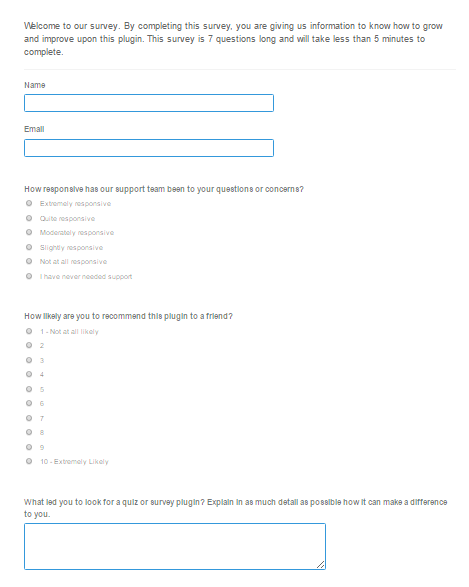Wouldn’t it be nice if you could read the minds of your customers to learn exactly what they’re thinking about your products or services? You could launch new products without dreading about features your customers may or may not like. And coming up with fresh, share-worthy blog topics wouldn’t take hours anymore!
Your customer would benefit from this ability, too. After all, blog topics that keep your customer’s interests in mind and time-saving products that they actually want are almost priceless if you’re helping them solve a problem or teaching them something new.
If you think this type of in-depth understanding sounds too good to be true, you’re in luck. You can successfully get in your customer’s head, sans Big Brother tactics. We’re talking about capturing your customer’s feedback through surveys.
If you’ve never used them before, or if you haven’t had much success using them in the past, we’ll show you exactly how to use them to capture your customer’s feedback — without annoying them — in today’s article.
[qsm_popup id=49698]Bonus: To help you get started, we’ve created this template of questions to ask so you’ll always get the right feedback.[/qsm_popup]
Here’s Why Capturing Feedback is Worth Your Time
Capturing feedback from your customers that you can actually use is no easy feat. It’s going to take some time and patience to sift for the golden nuggets that matter for your business. But trust us, this extra effort will certainly be worth the time investment.
Using surveys, you’ll be able to:
- Identify the specific problems your customer faces
- Get to know these struggles from your customer’s perspective
- Learn the exact language your customers use
- Understand your customer better
The more you understand your customer, the better you’ll be able to deliver a product or service that meets their needs. This extra effort will help you build loyal customers who can’t wait to share how your brand has helped them in some way. It’s really a win-win for both parties involved.
Create Surveys the Right Way
One of the best (and easiest) ways to capture your customer’s feedback is through online surveys. Using this method, customers can provide their feedback whenever they want, and from wherever they want, as long as they’re connected to the internet. This convenience makes it much easier for them to finish and will guarantee higher completion rates.
All you have to do is create one master survey for your customers to answer. Once the survey has been completed, you’ll automatically have the results in a downloadable and organized form, which means most of the heavy lifting is already done for you.
This all sounds promising, but there are a few specifics to keep in mind before you proceed.
Decide What Your Goals Are Before Moving Forward
It’s important that you clearly identify what you hope to accomplish with your survey. Are you looking for ideas for blog topics or do you want to know what features are most important to your customers?
Brainstorm a few of your goals for creating a survey in the first place. Think about what questions you’re expecting to answer with the help of customer feedback. By keeping this specific focus, you can tailor each question so that it aligns with your goals.
Respect Your Customer’s Time
One of the challenges survey users face is actually getting customers to complete them. That’s why it’s crucial that your surveys are as short and to-the-point as possible. Anything too long may force your customer to abandon ship, leaving you with less than insightful feedback (if any).
So to respect your customer’s time, keep your surveys under 10 questions. If you can whittle this number down to 5 questions or less, you’ll get even better responses.
When you promote your survey, it helps to mention upfront how many questions your survey-taker can expect. Think about this from your customer’s perspective: Answering 5 questions instead of 10 sounds less time-consuming, so your surveyor will be more likely to complete the questionnaire on the spot instead of put it off and forget about it.
Mix Up Some Easy Questions in Between
Someone may abandon your survey mid-way because it’s too long, while others will give up if the questions require too much effort on their part. That’s why it’s a good idea to mix in a few easy-to-answer questions between the ones that require a more thought-out response.
Easy questions have 2–4 responses to choose from, as opposed to a comment box where customers have to write out an answer. These questions have responses that are either yes/no, true/false, or multiple choice.
To get your survey momentum going, start out with 1–2 easy questions before you add a thought provoking one. If you decide to use a comment box answer — which you should — be sure to follow it up with a few easy questions to keep that momentum strong.
Here’s what an ideal order of questions should look like:
- Easy question, 2 answers to choose from
- Multiple choice question, up to 4 answers
- Thought provoking question, one comment box with unlimited characters
- Repeat as needed, max of 2.5 times
Ask for Their Feedback
Although those easy questions are great for audience participation, they won’t give you the tell-all feedback you’re looking for. Multiple choice answers force respondents to choose an answer you’ve already given to them — which doesn’t help capture your customer’s unbiased opinion.
Instead, sprinkle in a few comment boxes that give your participant the option to freely open up. You should set these boxes to an “unlimited character count” so users aren’t limited by how much they can type in a small box.
In a 10 question survey, keep the amount of comment box responses to about 4 (or 40% of your questions). The rest of your questions should be fairly easy so your participant doesn’t feel like helping you out is too much work.
If you’ve ever taken a survey that feels like it’s never going to end, you know exactly what we’re talking about. No one likes these surveys. When there’s a comment box at the end of a long survey, your respondent will be too tired to give you their all so you wind up with responses that are less than ideal. Since this sounds like a waste of everyone’s time, it’s best to avoid this route.
Stick to two easy questions followed by an open-ended response, and repeat this until you have a survey that makes sense for your goals (i.e. to capture blog article ideas, to find out what features are important to customers, etc.).
Promote Your Survey Without Annoying Your Audience
Once you’ve crafted the perfect survey, it’s time to promote it. But before you blast it out to your digital audience, make sure you can answer the following questions:
- How long will the survey take?
- How many questions are there?
- Why am I creating this survey?
- What will my respondents get in return?
What you’re offering in return can be anything from early access, a discount, access to a free guide, or anything else you can think of that’s a fitting reward for their time.
Keep these answers handy; whenever you promote your survey, you’ll be using them to entice respondents to complete the survey.
Here’s an example of what that looks like:
“Hi everyone! I have a simple 5 question [answer #2] survey that I’d really appreciate your help with. The survey takes about 2 minutes [answer #1] and can be done from anywhere. Essentially, I need your input so I can [answer #3] with your needs in mind. In return, I’ll give you [answer #4]”
Now that you have a template worked out, send the email to your mailing list. This targets your existing audience and will return answers from your core market. Separate the customers who have taken the survey from the ones who have not into two separate email lists. You can then send friendly reminders to those who haven’t taken the survey yet. Repeat this process about once or twice for the best results.
To get an outsider’s perspective, try promoting your survey on social media. Don’t annoy your followers — only promote your survey once a week for about a month. Anything more and people will begin tuning it out or getting annoyed.
Depending on your customer’s feedback, you can repeat the survey process every quarter or so. Just remember to keep our tips in mind and your audience will be happy to help.
To get started with your first survey, head over to our demo page to see what yours could look like.
[qsm_popup id=49698]Bonus: Don’t forget to download our free template of questions to ask so you’ll get the right feedback from your customers every time.[/qsm_popup]






